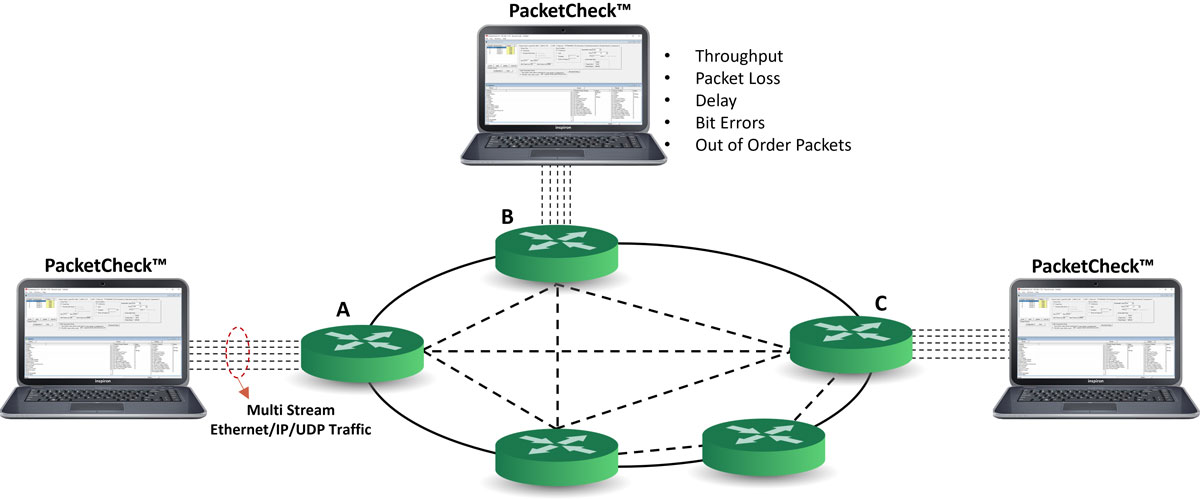Advanced Ethernet and IP Testing for LAN and WAN Networks
Welcome to the latest issue of GL's Newsletter, providing information into our PC-based Ethernet/IP test tool, PacketCheck™. This powerful and cost-effective real-time testing and monitoring solution is designed for Local Area Networks (LANs) and Wide Area Networks (WANs).

Overview
GL’s PacketCheck™ is a versatile, user-friendly PC-based Ethernet and IP software program designed for testing and verifying LANs and WANs. It can generate and analyze hundreds of Ethernet/IP/UDP streams, all with user-defined MAC and IP addresses, from a single PC.
PacketCheck™ offers extensive Ethernet testing, covering all protocol layers, from basic Ethernet frames to stacked VLAN, MPLS, and IP packets with UDP data. It uses the PC's Network Interface Card (NIC) to send and receive Ethernet and IP packets on LANs and WANs.
The application offers additional features such as simulating traffic by sending pre-recorded files and generating traffic with Interframe Gap (IFG) precision of up to 5 milliseconds. It includes Bit Error Rate (BER) testing capabilities using PRBS patterns or custom-defined test patterns.
PacketCheck™ works with Multi-link Frame Relay (MFR) and offers a traffic feature called MFR-IP-PacketCheck™ for generating IP traffic over Frame Relay (FR) links. It supports the generation and processing of multiple IP traffic streams across various Virtual Channels within the FR links. Each IP traffic stream can be customized to modify the IP packets with specific headers to emulate different modes, such as Bridge and Route.
Key Features
- Capability to test Ethernet/IP/UDP traffic of up to 500 Mbps bandwidth. Supports minimum line rate of 64 Bps
- Generate full duplex traffic at any of the four layers (Layer1, Layer2 (Ethernet) with stacked VLAN/ MPLS, Layer3 (IPv4), Layer4 (UDP)) with on-demand bandwidth
- BERT on layer 1, layer 2, layer 2.5, layer 3, and layer 4 with various measurements - Bit Error Rate, Sync Loss Count, Bit Error Count, and more
- Create multiple full-duplex streams per PacketCheck™ easily, with different frame size, rate, header, PRBS pattern etc. and check Throughput, Packet Loss, Packet Counts, and Out of Sequence packets per stream
- Supports frame sizes ranging from 22 bytes up to 1518
- Measure One-Way Delay (between two instances on 2 NIC cards on the same PC) or Round-Trip Delay (with remote loopback)
- Record per stream traffic to a Wireshark file (NGPCAP or NTAR format) or HDL file (GL Proprietary format). Separate files for each stream
- Playback from a Wireshark file (NGPCAP or NTAR format) or HDL file (GL Proprietary format), with customizable traffic rate
- Start or stop any stream at run-time independently
- Record unidentified network traffic into a PCAP or HDL file format
- Ability to resolve IP Address to MAC address for all streams with a single click, so that all streams are configured properly before starting the test
- Independently define each stream to operate as Layer 2 (Ethernet) or Layer 3 (IP) or Layer 4 (UDP)
- For Layer 3 or Layer 4 streams, analyzes the received payload based on the IP or UDP length and ignore any MAC padded bytes added in transit
- Supports Jumbo frames
- Transmission rate can be configured to operate in Burst mode or IFG mode
- PRBS Pattern generation/verification of various patterns like QRSS, 26-1, 29-1, 211-1, 215-1, 220-1, 223-1
- Generate various run-time impairments – insert/delete bytes, and byte level impairments
- Capability to generate/respond to Address Resolution Protocol (ARP) requests, making it easy to work with Routers
- Generate reports in XML or PDF formats
Applications
- Create multiple streams of traffic for network testing on Layer 2, 3, or 4
- Test for bit errors, packet loss, throughput, etc. over a network path
- Determine Round-trip delay between two endpoints with microsecond accuracy
- Determine One-Way Delay through an isolated device such as a switch or router
- Record test traffic in binary and/or PCAPNG or NTAR file format
- Playback PCAPNG files for test traffic generation. Either recorded from test BERT traffic or recorded traffic of interest
- Record non-test packets to a PCAPNG file. i.e., Non-BERT traffic related packets
 Back to Newsletter Index Page
Back to Newsletter Index Page